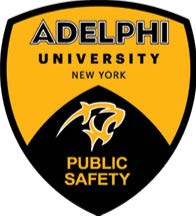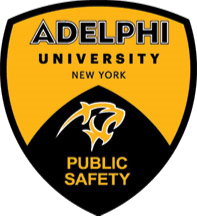Adelphi University recently completed a test of our Emergency Operations Plan (E.O.P.). Per the Clery Act (Jeanne Clery Disclosure of Campus Security Policy and Campus Crime Statistics Act), we are required to (1) test the university emergency response and evacuation procedures on at least an annual basis, and (2) publicize our emergency response and evacuation procedures, along with a summary of the test. The following notification is being sent to university employees and students to meet this requirement.
Dear Campus Community,
 Adelphi University recently completed a test of our Emergency Operations Plan (E.O.P.). Per the Clery Act (Jeanne Clery Disclosure of Campus Security Policy and Campus Crime Statistics Act), we are required to (1) test the university emergency response and evacuation procedures on at least an annual basis, and (2) publicize our emergency response and evacuation procedures, along with a summary of the test. The following notification is being sent to university employees and students to meet this requirement.
Adelphi University recently completed a test of our Emergency Operations Plan (E.O.P.). Per the Clery Act (Jeanne Clery Disclosure of Campus Security Policy and Campus Crime Statistics Act), we are required to (1) test the university emergency response and evacuation procedures on at least an annual basis, and (2) publicize our emergency response and evacuation procedures, along with a summary of the test. The following notification is being sent to university employees and students to meet this requirement.
Emergency Response Test November 29th, 2018
On November 29th, at approximately 10:00 hours, the Department of Public Safety conducted a Hostile Intruder Lock-Down Exercise at the Adelphi University Early Learning Center (ELC).
The lock-down exercise was based on best practices and lessons learned by the department from previously conducted drills and exercises here at Adelphi. This exercise was the culmination of several weeks of planning and coordination between The Department of Public Safety and the Faculty and Staff at the ELC. It was conducted without incident for a period of approximately fifteen (15) minutes and was intended to test and evaluate the department’s Emergency Operations Plan (EOP), as well as the following preparedness mission areas and core capabilities: Protection, Mitigation, and Response.
The exercise design consisted of a simulated phone call to the Public Safety Command Center indicating that there was a male with a firearm in the vicinity of ELC. This call initiated the exercise in which the anticipated action called for the Command Center officer to triage the call and take a series of actions intended to initiate a response from the Garden City Police Department, Adelphi Public Safety, and the exercise participants.
In the coming days, the department will undertake an after action review (AAR) process intended to provide an overview of the exercise highlighting successes, lessons learned, and areas for improvement. It is anticipated that this AAR process will position the department for success in future exercises and in the event of a real time incident.
Emergency Operations Plan
The Adelphi University Emergency Operation Plan (EOP) has been designed as a guide for administrators and their designees in planning for, and responding to, campus emergencies. This EOP utilizes an all hazards approach and covers an ever-expanding scenario of situations common to us as well as newer threats, which need to be planned for in the 21st century.
The all-hazard EOP will provide structure and operational coordination when implemented for the Garden City Campus, Hauppauge Education and Conference Center, Manhattan Center, and Hudson Valley Center. The EOP contains various components that, when a situation occurs, will allow for maximum flexibility to facilitate operational coordination and information-sharing between the campus and outside agencies.
In addition, the EOP includes the Emergency Notification Procedure. If a situation arises that poses a verified, imminent or ongoing threat to the safety, security, or health of students or employees, an Adelphi Alert (Emergency Notification) will be sent to transmit specific information about an emergency. The goal of the alert is to ensure individuals are aware of the situation and that they know the steps to take for personal and community safety.
The Department of Public Safety and Transportation tests the University Mass Notification System at least once every calendar year, and such tests may be announced or unannounced. The campus also tests its emergency response and evacuation procedures on at least an annual basis. Furthermore, tabletop emergency exercises are conducted on an annual basis.General information about the emergency response and evacuation procedures for Adelphi University are published each year as part of the institution’s Clery Act compliance efforts in the Annual Security and Fire Safety Report.
Shelter-In-Place
What it means to “Shelter-in-Place”
If severe weather or an incident occurs and the buildings or areas around you become unstable, or if the air outdoors becomes dangerous due to toxic or irritating substances, it is usually safer to stay indoors, because leaving the area may expose you to that danger. Thus, to “shelter-in-place” means to make a shelter of the building that you are in, and with a few adjustments this location can be made even safer and more comfortable until it is safe to go outside.
Basic “Shelter-in-Place” Guidance
If an incident occurs and the building you are in is not damaged, stay inside in an interior room until you are told it is safe to come out. If your building is damaged, take your personal belongings (purse, wallet, etc.) and follow the evacuation procedures for your building (close and lock your door, proceed to the nearest exit, and use the stairs instead of the elevators). Once you have evacuated, seek shelter at the nearest university building quickly. If police or fire department personnel are on the scene, follow their directions.
How You Will Know to “Shelter-in-Place”
A shelter-in-place notification will come from the Department of Public Safety via the RAVE university mass notification system and/or Emergency Public Address System announcement.
How to Shelter in-Place
If an incident occurs where sheltering-in-place is the best option, follow these steps, unless instructed otherwise by emergency personnel:
These steps should only be followed if safe to do so:
- When you are notified of an emergency, seek or remain in a location that is safe from the affected area.
- When in a safe area, attempt to secure the space in whatever reasonable manner is applicable.
- Stay in the safe area and remain quiet, unless making noise would b e beneficial to your safety (i.e. to increase the likelihood of rescue or recovery).
- Stay away from objects that may lead to higher risk of injury (i.e. windows during a storm).
- Do not leave the area of safety until you are notified that the emergency is no longer a threat to personal safety.
For information on How to Shelter in Place Please visit the Safety.Adelphi.Edu website.
The Department of Public Safety hopes that this information is useful to all those who work, study, and visit our campus community. If you have questions or concerns, please contact the Department of Public Safety.
Working together as a community, we will continue to ensure a safe environment for everyone at Adelphi University.
Pride.Professionalism.Service
Sincerely,
Public Safety and Transportation
For further information, please contact:
Public Safety and Transportation
Levermore Hall, Suite 113
p – 516.877.3500 or dial “5” from any on-campus phone
